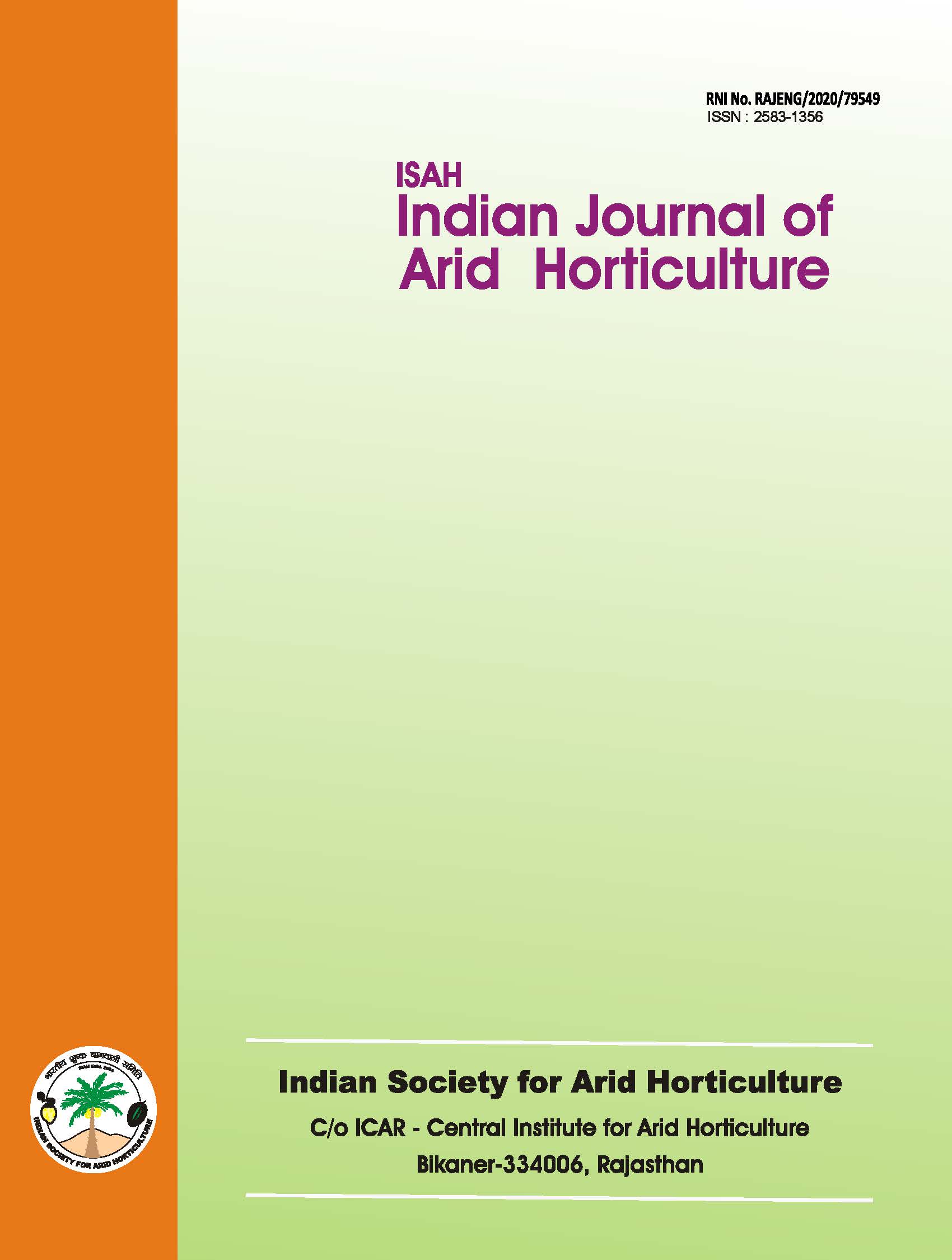Emerging vistas in post harvest paradigm of guava
DOI:
https://doi.org/10.48165/Keywords:
Guava, processing, juice, nectar, vitamin AAbstract
Guava (Psidium guajava L.), a common man's fruit commonly called the "apple of the tropics" is cultivated or grown wild throughout the tropical and subtropical regions of the world. India's output of guava increased from 10.15 lakh tonnes in 1989-90 to 16.85 lakh tonnes in 2004-05. The area rose from 1.03 lakh ha. to 1.62 lakh ha. with a yield of 11.10 tha'. Guava is one of the richest sources of vitamin C (200 to 400 mg per 100g fresh weight) and some cultivars are also rich in vitamin A. Guava fruit consists of about 20% peel, 50% fleshy portion, and 30% seed core. It contains 74-87% moisture, 13-26% dry matter, 0.8-1.5% proteins, 0.4-0.7% fat, and 0.5-1.0% ash. It is one of favourite fruit, which can be utilized for processing however selection of guava varieties for processing depends on several factors such as content of pulp, seeds, sugars, acids, pectin, and tannins in the fruit. The guava fruit can be consumed fresh; processed into a semiproduct in the form of puree, clarified juice, or concentrate and frozen or aseptically stored; or processed continuously to the final products, which include nectar, syrup, jam, jelly, fruit bar, cheese, chutney, ketchup, wine, dried fruit and powder, as well as canned guavas. Among them, guava nectar is more important than the others in the quantity of production and the popularity among consumers. The fruits of Sardar variety yield high-grade pectin with higher jelly units than the fruits from other varieties. Juice obtained from fresh fruits or from pulp can be used in the manufacture of clear guava nectar, clear guava juice blend, clear guava jelly, or guava powder.Downloads
References
Adisa, V. A. (1985). Fruit rot diseases of guava (Psidium guajava L.) in Nigeria. Indian Phytopathology, 38, 42.
Adsule, P. G., & Tandon, D. K. (1983). The assessment of LDP bags for enhancing shelf-life of guava. Indian Food Packer, 37, 82.
Ahire, A. A. (1989). Studies on the development of preserved products from guava (Psidium guajava L.). (M.Sc. thesis). Mahatma Phule Agricultural University, Rahuri, Maharashtra.
Akamine, E. G., & Goo, T. (1979). Respiration and ethylene production in fruits of species and cultivars of Psidium and species of Eugenia. Journal of the American Society of Horticulture, 4, 631.
Ambadan. (1973). Some new fruit beverages. Indian Horticulture, 18, 5.
Amen, K. I. A. (1987). Effect of post-harvest calcium treatment on the storage life of guava fruits. Asian Journal of Agricultural Science, 8, 127.
Ananta, Diwan, & Shukla, S. S. (2004). Effects of treatments on reducing sugar and titrable acidity of low-alcoholic beverage prepared from guava (Psidium guajava). Journal of Food Science and Technology, 41(2), 210-213.
Aurora, S. H., Chan, T. Jr., Catherine, G. C., & Conrad, O. P. (1990). Physical-chemical characteristics of partially clarified guava juice and concentrate. Journal of Food Science, 55, 1757.
Bardiya, M. C., Kundy, B. S., & Tanro, P. (1974). Studies on fruit wines—Guava wine. Haryana Journal of Horticulture Science, 3, 140.
Bons, H. K., & Dhawan, S. S. (2003). Effect of preserved guava pulp on the quality of ready-to-serve beverage. Crop Research Hisar, 25(2), 360-363.
Bourgeois, P., Aurore, G. S., Abaul, J., & Joseph, H. (1998). Processing guava seeds: Kernel oil and abrasive shell powder. Cahiers Agricultures, 7(2), 105-109.
Brat, P., Olle, D., Reynes, M., Alter, P., Brillouet, J. M., Cogat, P. O., & Drew, R. (2002). Preparation of tropical fruit purees by flash vacuum-expansion. Acta-Horticulturae, 575(2), 535-541.
Brekke, J. E., & Myers, A. L. (1978). Viscometric behavior of guava purees and concentrates. Journal of Food Science, 43, 272.
Brown, B. I., & Wills, R. B. H. (1992). Post-harvest changes in guava fruit of different maturity. Scientific Horticulture, 19, 237.
Campbell, B. A., & Campbell, C. W. (1983). Preservation of tropical fruits by drying. Proc. Fla. State Hort. Soc, 96, 229.
CFTRI. (1990). Guava in India. Central Food Technological Research Institute, Mysore, India.
Chan, H. T., & Caveletto, C. G. (1982). Aseptically packaged papaya and guava puree: Changes in chemical and sensory quality during processing and storage. Journal of Food Science, 1164.
Chan, H. T. Jr., & Cavaletto, C. G. (1986). Effects of deaeration and storage temperature on quality of aseptically packaged guava puree. Journal of Food Science, 5, 165.
Chan, H. T. (2004). Frozen guava and papaya products. Jr Handbook of Frozen Foods, 473-482.
Chauhan, S. K., & Sharma, R. C. (1997). Fortification of fruits and ginger with soybean for protein-rich toffees. Indian Journal of Nutrition and Dietetics, 34(5), 134-139.

